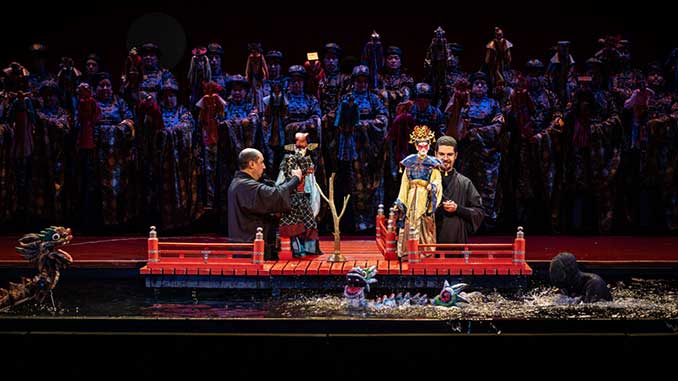 Since its first staging in 2009 in Toronto, Canadian director Robert Lepage’s splendiferous production of Igor Stravinsky’s first opera, The Nightingale, has accumulated a sky full of stars along its way. It’s easy to understand why.
Since its first staging in 2009 in Toronto, Canadian director Robert Lepage’s splendiferous production of Igor Stravinsky’s first opera, The Nightingale, has accumulated a sky full of stars along its way. It’s easy to understand why.
Stravinsky’s The Nightingale is an enchanting and short 45-minute work that premiered in 1914, based on the fairytale by Hans Christian Andersen (published in 1843) and is the main fare of a two-part entertainment.
The work is preceded by several tantalising bite-sized hors d’oeuvres and, together with The Nightingale, the production – a co-production of Opéra National de Lyon, Festival d’Aix-en-Provence, Canadian Opera Company and Dutch National Opera, in collaboration with Ex Machina (Canada) – essays and honours Stravinsky’s early compositional writing marvellously.
And with masterful puppetry involved and a stage pit full of water that sets the scene evocatively, it’s impossible not to be awestruck by its magical entirety.
The first part begins with the joyful, quirky and inventive sounding orchestral work Ragtime (1918), showing off its charming laissez-faire aura, and ends with The Fox (Renard), a somewhat gruesome moralising farmyard folk tale concerning the punishment of deceit which premiered in 1916.
For this, four male voices dressed in Russian folk tunics and fur-trimmed hats – Andrew Goodwin, Owen McClausland, Taras Berezhansky and Nabil Suliman – bring enormous character and neatly calibrated humour as Asian inspired shadow puppetry enamours at the rear.
In between, fabulously dark and plummy contralto Meredith Arwady unashamedly promotes drinking to get drunk in Pribaoutki and the shenanigans of cats in Berceuses du chat.
Also featured is the effortlessly radiant soprano of Yuliya Pogrenyak in The Two Poems of Konstantin Balmont and, punctuating the first part, clarinettist Dean Newcomb brings willowy seduction combined with music-making mimicking exquisite butterfly-like trajectories in Three Pieces for Solo Clarinet.
Accompanying the performances, although you could say stealing them, so riveting are the copious creations of birds, rabbits and cats, amongst other creatures, it may take an embarrassing few minutes to realise the shadow puppetry is created by five artists utilising the light of a red lantern mounted to the left of the stage on an oriental platform. Admittedly, my excuse is that I was seated on the opposite side of the theatre.
 The Nightingale is something else! At the very least, Lepage has inspired and juggled an incredible workshop of creative talent. The combined efforts of set designer Carl Fillion, puppet designer Michael Curry, costume, wig and makeup designer Maria Gottler and lighting Etienne Boucher add up to a visually poetic pièce de résistance matched with the poetry of Stravinsky’s score and the rippling sensitivity of its Russian libretto by the composer and Stepan Mitusov.
The Nightingale is something else! At the very least, Lepage has inspired and juggled an incredible workshop of creative talent. The combined efforts of set designer Carl Fillion, puppet designer Michael Curry, costume, wig and makeup designer Maria Gottler and lighting Etienne Boucher add up to a visually poetic pièce de résistance matched with the poetry of Stravinsky’s score and the rippling sensitivity of its Russian libretto by the composer and Stepan Mitusov.
Set in ancient China and glinting with its (inarguably/arguably) inoffensive chinoiserie exotica, The Nightingale is a soothing, meditative balm – much like how, as the Fisherman tells us, the Nightingale’s beautiful birdsong washes away the woes of the world.
Significantly, it packs a story of friendship and forgiveness as well as highlighting the power of beauty, art and nature to soothe, as something not to be owned or territorialised but pondered and appreciated.
A mounted base drum at the rear captures the light to evoke a moonlit sky, a twisted tree hangs over the orchestra pit ‘lake’ and a little craft carrying the Fisherman cuts the water in early morning fog as he awaits the Nightingale. The opening scene immediately captivates. The remainder thoroughly entrances.
Notably, the intoxicating delight of predominantly Japanese bunraku-styled puppetry and the power of operatic voice are inextricably combined. Lepage’s cast not only sing their roles with fervency and purpose but operate their puppet characters convincingly, both on land and in water.
Yuliia Zasimova enriches and touches to no end as the titular Nightingale with her emotively penetrating, crystalline soprano and McCausland returns in affecting tenor voice as the simple but wisely environmentally connected Fisherman.
Berezhansky’s exceptional bass is appropriately authoritative and shaded as the Emperor, Pogrenyak brings infectious charm to the Emperor’s servant and rewarded Cook and Arwady makes another mammoth impact as Death when she appears under the skull as part of a giant skeleton that unfolds during the remarkable transformation around the dying Emperor on his bed.
Other smaller roles are no less impactful, complimented by the regimentally sound Adelaide Symphony Orchestra Chorus who continue the many surprises when they reveal their individual puppets from under their long sleeved robes.
And keeping it all together, Argentinian conductor Alejo Pérez clearly relished dancing at the helm. In this final performance, Stravinsky’s music shone, the tempi drew in the subtle moods and the excellence of the ASO never waned.
In a startling final act, Pérez took a plunge into the watery pit at curtain call. I’m sure many of us would have loved to have joined him in this triumph and celebration of pure and unforgettable meditative balm.
The Nightingale and Other Fables
Festival Theatre – Adelaide Festival Centre, King William Road, Adelaide
Performance: Wednesday 6 March 2024
Season: 1 – 6 March 2024
Information: www.adelaidefestival.com.au
Images: The Nightingale and Other Fables – photos by Andrew Beveridge
Review: Paul Selar
